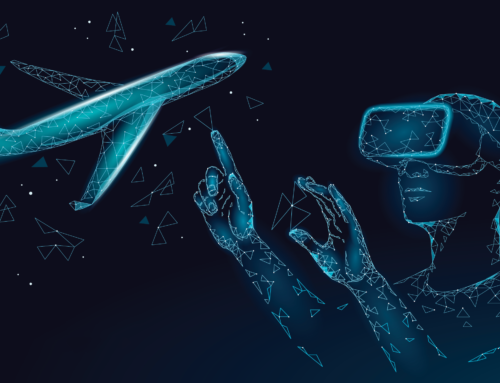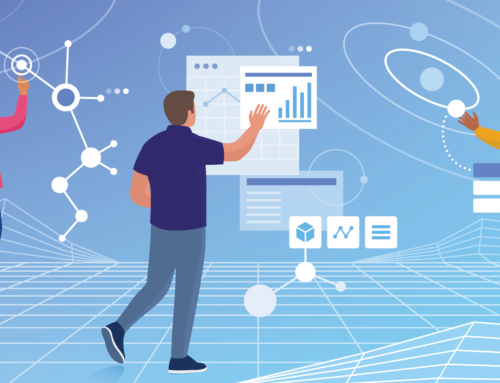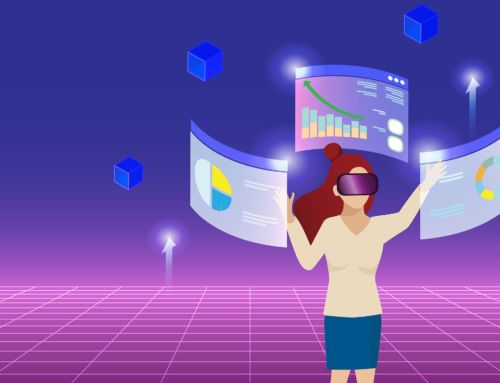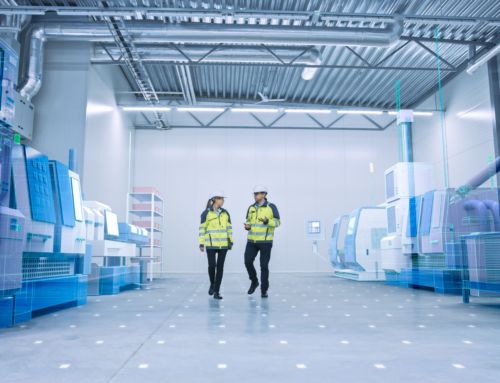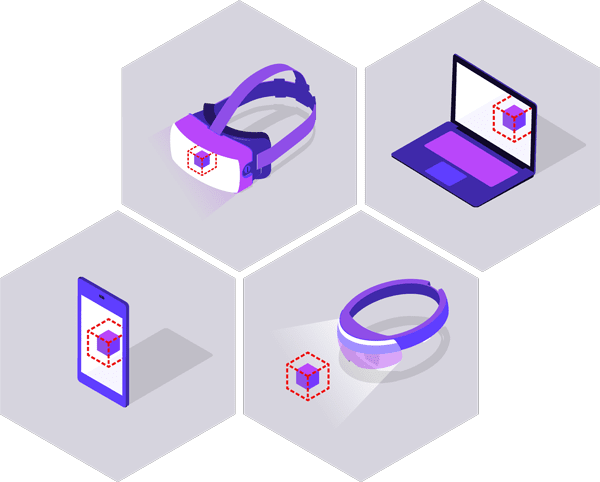Digital transformation is the process of revolutionising business processes through the adoption of digital technologies. It encompasses reimagining all aspects of a business – from administrative procedures through to corporate culture, customer relationship management and skills development, to address changing business and market needs.
While digital transformation brings tangible benefits to businesses and individuals alike, it also raises a range of challenges that need to be addressed to fully realise the potential of digital technologies. The key to successful adoption is ensuring that everyone working within a business has the skills and abilities to exploit the opportunities that digital transformation brings – and that’s where the challenge lies for learning and development teams.
Why the Need for Digital Transformation
There are numerous business motivations for introducing digital transformation strategies, including:
Addressing changing workforce demographics
The labour market is in a state of flux, with a growing percentage of digital natives establishing their influence across the workforce. Millennials and Gen Z’ders are increasingly discerning in who they want to work for and their motivations for joining a company need to be met through rigorous training and development programmes and flexible working conditions. Having a comprehensive Digital Transformation strategy can therefore make a tangible difference for companies looking to attract new talent and inject crucial skills.
Meeting customer expectations
Increasingly in the Digital Age, customers have high expectations that are driving businesses to change. Digital transformation can lead to improved customer service, from simplifying purchasing processes, improving delivery time and post-purchase care. In return, businesses can benefit from getting to know their customers better by developing easily accessible customer records, as well as collecting and analysing enriched data to help develop and successfully market new customer-driven products and services.
Tackling the impact of the pandemic
Since early 2020, companies have had to adapt quickly to the monumental change that the Covid pandemic has brought – and digital transformation has held the key to survival (and for some, to thrive) throughout these challenging times. For many, this has meant that digitising core activities has played a crucial role to support remote working, online activity and streamlining supply chains. Put simply, adopting a digital mindset has given forward thinking businesses the competitive edge.
How Digital Transformation Impacts Learning and Development
Although digital transformation can be hugely beneficial to businesses, as with any significant change, it also brings disruption and can be met with resistance. Its impact is felt across all areas of a business and as such, this brings new challenges to Learning and Development teams in ensuring that businesses and employees are fully prepared for, and able to fully exploit, the changes that digital transformation promises.
Addressing changing working patterns
Traditional models of working, where the world of work is tied to a central workplace is changing, as remote and hybrid working become increasingly commonplace in response to Covid lockdowns. But this is potentially accelerating change in the longer term, where companies such as Premier Foods are seeing: “work is a verb, not a place.”
By changing where we work, we also change how we work. Reliance on digital technologies is the key to remote working. This raises numerous challenges for Learning & Development departments to ensure that individuals are being fully supported. This goes beyond simply ensuring that employees know how to use equipment and platforms to work effectively from remote locations. It does, in effect, fundamentally change L&D processes and procedures to identify, address and monitor skills development.
Retraining existing employees to learn new skills and adapt to change
Digital transformation brings change and short term disruption to a company. As with any change management strategy, the key to success is getting buy-in from employees, who may feel suspicious, or even threatened by the introduction of new technologies. Businesses cannot afford to lose the knowledge acquired over a lifetime by older employees. To address this, learning and development teams need to strike the balance between old and new, developing lifelong learning strategies to address the long term changes in skills needs where artificial intelligence and automation are replacing traditional roles, and retrain older employees so that they can adapt to change and apply their expertise in meaningful ways.
Attracting new talent
Great companies don’t simply need to retain existing employees, they need to attract new talent and address skills gaps within an organisation. The next generation of employees are increasingly discerning about who they work for. Embracing digital technologies and providing an attractive skills development programme can make all the difference to securing the perfect candidate for hard-to-fill vacancies.
How can L&D Support Digital Transformation
There are some key practical measures that L&D teams can implement to support digital transformation within their organisations. These can include:
Shift to employee-centred, active learning
The digital transformation of training means that traditional classroom learning is increasingly becoming a thing of the past. By adopting digital solutions such as online courses or VR experiences, training programmes can help to upskill remote employees and onboard new members of the team. It can help to transform L&D strategies from a ‘one size fits all’ to highly personalised, flexible learning experiences, where employees can feel empowered and motivated to develop new skills.
Adopt immersive technologies
Introducing new technologies, such as virtual, augmented and mixed reality offer brilliant tools for interactive, hands-on training experiences. This can help to rapidly train employees in practical and technical roles, through developing soft skills to improve customer experiences.
Building a rigorous CPD programme that is measurable
The digitisation of training programmes means that performance during, and post-training impact can be measured. Digital training programmes can feed automatically into an employee’s HR records, helping to benchmark abilities that can be re-tested to check the long term impact of any training intervention.
Leading by example
By championing digital skills interventions, L&D teams can help to sell the benefits of digital transformation across an organisation. By becoming more digitally-savvy, L&D professionals can gain a deeper understanding of new training processes, feed into improvements in training programmes and as well as becoming more open to introducing future innovations.
Conclusion
Digital transformation is transcending all aspects of business, streamlining processes, boosting productivity and improving customer service. It is also proving to be fundamental to the future of learning and development strategies – and immersive technologies, such as virtual and augmented reality (VR and AR) are increasingly being recognised as a digital innovation that can make a tangible contribution in driving skills development programmes.
Recent developments in immersive technologies, from improvements in content creation to the availability and affordability of hardware and platforms means that VR and AR are more accessible to businesses, and crucially, meet the needs of human-centred technologies to address employee centred skills development. Put simply, immersive technologies are fit for learning and development purposes, by creating digital worlds to learn and perfect new skills, helping teams to work better together and ultimately transform how businesses perform.
Digital transformation is the process of revolutionising business processes through the adoption of digital technologies. It encompasses reimagining all aspects of a business – from administrative procedures through to corporate culture, customer relationship management and skills development, to address changing business and market needs.
While digital transformation brings tangible benefits to businesses and individuals alike, it also raises a range of challenges that need to be addressed to fully realise the potential of digital technologies. The key to successful adoption is ensuring that everyone working within a business has the skills and abilities to exploit the opportunities that digital transformation brings – and that’s where the challenge lies for learning and development teams.
Why the Need for Digital Transformation
There are numerous business motivations for introducing digital transformation strategies, including:
Addressing changing workforce demographics
The labour market is in a state of flux, with a growing percentage of digital natives establishing their influence across the workforce. Millennials and Gen Z’ders are increasingly discerning in who they want to work for and their motivations for joining a company need to be met through rigorous training and development programmes and flexible working conditions. Having a comprehensive Digital Transformation strategy can therefore make a tangible difference for companies looking to attract new talent and inject crucial skills.
Meeting customer expectations
Increasingly in the Digital Age, customers have high expectations that are driving businesses to change. Digital transformation can lead to improved customer service, from simplifying purchasing processes, improving delivery time and post-purchase care. In return, businesses can benefit from getting to know their customers better by developing easily accessible customer records, as well as collecting and analysing enriched data to help develop and successfully market new customer-driven products and services.
Tackling the impact of the pandemic
Since early 2020, companies have had to adapt quickly to the monumental change that the Covid pandemic has brought – and digital transformation has held the key to survival (and for some, to thrive) throughout these challenging times. For many, this has meant that digitising core activities has played a crucial role to support remote working, online activity and streamlining supply chains. Put simply, adopting a digital mindset has given forward thinking businesses the competitive edge.
How Digital Transformation Impacts Learning and Development
Although digital transformation can be hugely beneficial to businesses, as with any significant change, it also brings disruption and can be met with resistance. Its impact is felt across all areas of a business and as such, this brings new challenges to Learning and Development teams in ensuring that businesses and employees are fully prepared for, and able to fully exploit, the changes that digital transformation promises.
Addressing changing working patterns
Traditional models of working, where the world of work is tied to a central workplace is changing, as remote and hybrid working become increasingly commonplace in response to Covid lockdowns. But this is potentially accelerating change in the longer term, where companies such as Premier Foods are seeing: “work is a verb, not a place.”
By changing where we work, we also change how we work. Reliance on digital technologies is the key to remote working. This raises numerous challenges for Learning & Development departments to ensure that individuals are being fully supported. This goes beyond simply ensuring that employees know how to use equipment and platforms to work effectively from remote locations. It does, in effect, fundamentally change L&D processes and procedures to identify, address and monitor skills development.
Retraining existing employees to learn new skills and adapt to change
Digital transformation brings change and short term disruption to a company. As with any change management strategy, the key to success is getting buy-in from employees, who may feel suspicious, or even threatened by the introduction of new technologies. Businesses cannot afford to lose the knowledge acquired over a lifetime by older employees. To address this, learning and development teams need to strike the balance between old and new, developing lifelong learning strategies to address the long term changes in skills needs where artificial intelligence and automation are replacing traditional roles, and retrain older employees so that they can adapt to change and apply their expertise in meaningful ways.
Attracting new talent
Great companies don’t simply need to retain existing employees, they need to attract new talent and address skills gaps within an organisation. The next generation of employees are increasingly discerning about who they work for. Embracing digital technologies and providing an attractive skills development programme can make all the difference to securing the perfect candidate for hard-to-fill vacancies.
How can L&D Support Digital Transformation
There are some key practical measures that L&D teams can implement to support digital transformation within their organisations. These can include:
Shift to employee-centred, active learning
The digital transformation of training means that traditional classroom learning is increasingly becoming a thing of the past. By adopting digital solutions such as online courses or VR experiences, training programmes can help to upskill remote employees and onboard new members of the team. It can help to transform L&D strategies from a ‘one size fits all’ to highly personalised, flexible learning experiences, where employees can feel empowered and motivated to develop new skills.
Adopt immersive technologies
Introducing new technologies, such as virtual, augmented and mixed reality offer brilliant tools for interactive, hands-on training experiences. This can help to rapidly train employees in practical and technical roles, through developing soft skills to improve customer experiences.
Building a rigorous CPD programme that is measurable
The digitisation of training programmes means that performance during, and post-training impact can be measured. Digital training programmes can feed automatically into an employee’s HR records, helping to benchmark abilities that can be re-tested to check the long term impact of any training intervention.
Leading by example
By championing digital skills interventions, L&D teams can help to sell the benefits of digital transformation across an organisation. By becoming more digitally-savvy, L&D professionals can gain a deeper understanding of new training processes, feed into improvements in training programmes and as well as becoming more open to introducing future innovations.
Conclusion
Digital transformation is transcending all aspects of business, streamlining processes, boosting productivity and improving customer service. It is also proving to be fundamental to the future of learning and development strategies – and immersive technologies, such as virtual and augmented reality (VR and AR) are increasingly being recognised as a digital innovation that can make a tangible contribution in driving skills development programmes.
Recent developments in immersive technologies, from improvements in content creation to the availability and affordability of hardware and platforms means that VR and AR are more accessible to businesses, and crucially, meet the needs of human-centred technologies to address employee centred skills development. Put simply, immersive technologies are fit for learning and development purposes, by creating digital worlds to learn and perfect new skills, helping teams to work better together and ultimately transform how businesses perform.








